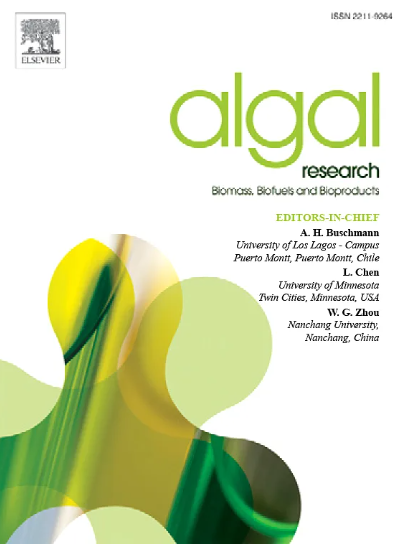通过对活性氧和共生菌谱的综合分析,揭示了它们对糖精菌核发育的潜在影响
IF 4.5
2区 生物学
Q1 BIOTECHNOLOGY & APPLIED MICROBIOLOGY
Algal Research-Biomass Biofuels and Bioproducts
Pub Date : 2025-06-03
DOI:10.1016/j.algal.2025.104122
引用次数: 0
摘要
共生细菌与海藻的生长发育密切相关,主要是由于它们分泌生物活性代谢物的能力。活性氧(Reactive oxygen species, ROS)在粳稻生长发育中起着重要的调节作用,但在粳稻营养区和胚孔区共生细菌群落与活性氧之间的相互作用尚不清楚。本研究测定了粳稻营养区和疮口区活性氧(ROS)、丙二醛(MDA)和NADPH的含量。结果显示,大鼠生殖腺区ROS、MDA和NADPH浓度显著升高,表明生殖区氧化环境升高。采用16S rRNA基因扩增子测序,对附生和内生细菌群落进行分析。比较分析显示,植物区和菜地区内生细菌的多样性和组成存在显著差异。值得注意的是,根瘤菌科核心属norank_f_Rhizobiaceae与NADPH积累呈强正相关,表明其在粳稻氧化过程调节和全离子功能稳定性中都有潜在的作用。这些发现提示了共生细菌与ROS代谢在日本海参发育过程中的潜在相互作用,为理解和改进海藻的培养策略提供了新的视角。本文章由计算机程序翻译,如有差异,请以英文原文为准。
Combined analysis of reactive oxygen species and symbiotic bacteria profiles reveals their potential effects on the sorus development of Saccharina japonica
Symbiotic bacteria are highly associated with the growth and development of seaweeds, primarily due to their ability to secrete bioactive metabolites. Reactive oxygen species (ROS) play a critical role in regulating growth and development in S. japonica, but the interactions between symbiotic bacterial communities and ROS on the vegetative and sorus areas of S. japonica remain unclear. In this study, the content of ROS (hydrogen peroxide), malondialdehyde (MDA) and NADPH in the vegetative and sorus areas of S. japonica were determined. Results revealed significantly higher concentration of ROS, MDA, and NADPH in the sorus area, indicating an elevated oxidative environment in reproductive areas. Using 16S rRNA gene amplicon sequencing, both epiphytic and endophytic bacterial communities were analyzed. Comparative analysis revealed pronounced divergence in endophytic bacterial diversity and composition between vegetative and sorus areas. Notably, the core genera norank_f_Rhizobiaceae exhibited strong positive correlations with NADPH accumulation, suggesting their potential role in both oxidative process modulation and holobiont functional stability of S. japonica. These findings suggest potential interactions between symbiotic bacteria and ROS metabolism during S. japonica sorus development, offering new perspectives for understanding and potentially improving seaweeds cultivation strategies to enhance stress resilience.
求助全文
通过发布文献求助,成功后即可免费获取论文全文。
去求助
来源期刊

Algal Research-Biomass Biofuels and Bioproducts
BIOTECHNOLOGY & APPLIED MICROBIOLOGY-
CiteScore
9.40
自引率
7.80%
发文量
332
期刊介绍:
Algal Research is an international phycology journal covering all areas of emerging technologies in algae biology, biomass production, cultivation, harvesting, extraction, bioproducts, biorefinery, engineering, and econometrics. Algae is defined to include cyanobacteria, microalgae, and protists and symbionts of interest in biotechnology. The journal publishes original research and reviews for the following scope: algal biology, including but not exclusive to: phylogeny, biodiversity, molecular traits, metabolic regulation, and genetic engineering, algal cultivation, e.g. phototrophic systems, heterotrophic systems, and mixotrophic systems, algal harvesting and extraction systems, biotechnology to convert algal biomass and components into biofuels and bioproducts, e.g., nutraceuticals, pharmaceuticals, animal feed, plastics, etc. algal products and their economic assessment
 求助内容:
求助内容: 应助结果提醒方式:
应助结果提醒方式:


